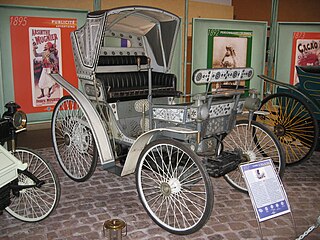
Peugeot is a French automobile brand owned by Stellantis.

Simca was a French automaker, founded in November 1934 by Fiat S.p.A. and directed from July 1935 to May 1963 by Italian Henri Pigozzi. Simca was affiliated with Fiat and, after Simca bought Ford's French subsidiary, became increasingly controlled by Chrysler. In 1970, Simca became a brand of Chrysler's European business, ending its period as an independent company. Simca disappeared in 1978, when Chrysler divested its European operations to another French automaker, PSA Peugeot Citroën. PSA replaced the Simca brand with Talbot after a short period when some models were badged as Simca-Talbots.

The Peugeot 104 is a supermini car produced by the French company Peugeot between 1972 and 1988. It was designed by Paolo Martin was initially only sold as a four-door saloon car, with a three-door hatchback variant introduced in 1974 and a five-door hatchback version replacing the saloon in 1976. The 104 was the first model produced at the company's Mulhouse plant. It was also the first new Peugeot introduced since 1955 not to be offered in a diesel version.

The Peugeot 403 is a mid-size car manufactured and marketed by Peugeot between May 1955 and October 1966. A total of 1,214,121 of all types, including commercial models, were produced, making it the first Peugeot to exceed one million in sales.

The Peugeot VLV was an electric microcar made by Peugeot in 1942. VLV stood for Voiture Légère de Ville. The car's announcement, on 1 May 1941, triggered some surprise, since Peugeot was the only one of France's large automakers to show interest in electric propulsion at this time.

The Peugeot 202 is a supermini developed and designed by the French car manufacturer Peugeot. Production of the car ran between 1938 and 1942 and then, after a brief production run of 20 in early 1945, restarted in mid-1946. It was sold until 1949, by when it had been replaced by the 203.

The Citroën Type C was a light car made by the French Citroën car company between 1922 and 1926 with almost 81,000 units being made. Known as Citroën 5HP or 5CV in France and 7.5HP in Britain, it was the second model of automobile designed and marketed by André Citroën, between 1922 and 1926. It followed the 10HP "Type A " (1919), then 10HP "B2" (1921); they were the first European mass-produced cars.

The Peugeot 201 is a car produced by Peugeot between 1929 and 1937.

The Peugeot 301 is a four-cylinder large family car produced by Peugeot between 1932 and 1936.

The Peugeot 402 is a large family car produced by Peugeot in Sochaux, France, from 1935 to 1942. It was unveiled at the Paris Motor Show in 1935, replacing the Peugeot 401.

Peugeot 5CV was a popular name for several models of the Peugeot Type 172 between 1925 and 1929.

The Peugeot Bébé or Baby was a small car nameplate from Peugeot made from 1905 to 1916. Vehicles under this name were known technically within Peugeot as the Type 69 and the Type BP1.

The Peugeot Type 175 was a fairly large sports car from Peugeot produced in 1923 and 1924. This model was produced at the factory in Audincourt. The OHV engine, of the LA5 range, displaced 3.0 L and has a 4 speed gearbox. It was only available with the "torpedo sport" or "torpedo grand sport" body at the price of 38,000 old Francs. Colours offered were blue, grey, green or red, with black wings and chassis. The body was made of a wooden frame with steel; the bonnet was made of aluminium with a sloping, nickel-plated window. Blériot headlights and a 12V SEV magneto and starter were fitted. In 1924, H. Petit won the 3-litre category of the 1100 km Paris-Nice race in this model: The "Paris Nice" Peugeot 175 Torpedo Grand Sport

The Peugeot Type 4 was a one-off car produced by Peugeot in 1892 for Ali III ibn al-Husayn, the Bey of Tunis, in accordance with whose wishes the car was decorated.

The Peugeot Type 5 was a small car by Peugeot, produced from 1893 to 1896. Mechanically, little was changed from the Peugeot Type 3. The engine and most of the mechanical parts were unchanged, but the car was shorter, lighter, and correspondingly made more of its 2 horsepower. However, against larger models from Peugeot, this car did not fare well. A total of 14 were sold.
Autobleu was a French automotive parts manufacturer based in Paris. They produced a variety of components, but were best known for their intake and exhaust manifolds. They also built a small number of customized cars based on models from larger manufacturers.
Danielle Bleitrach is a French sociologist and journalist. From the 1970s through the end of the century, she was CNRS researcher and lecturer at the Aix-Marseille University, focusing on the sociology of the working class and urbanization. From 1981 to 1996 she was a member of the Central Committee of the Communist Party of France, then the National Committee of the Party. She was also assistant editor-in-chief of the party weekly Révolution. She has contributed to La Pensée, Les Temps Modernes and Le Monde Diplomatique. In the 2000s and 2010s, after retiring from teaching, she co-authored texts on Cuba, Nazism and Ukraine.

The Citroën B10 is an automobile produced by Citroën at André Citroën's factory in central Paris between 1924 and 1925.

The Yehawmilk stele, de Clercq stele, or Byblos stele, also known as KAI 10 and CIS I 1, is a Phoenician inscription from c.450 BC found in Byblos at the end of Ernest Renan's Mission de Phénicie. Yehawmilk, king of Byblos, dedicated the stele to the city’s protective goddess Ba'alat Gebal.

















